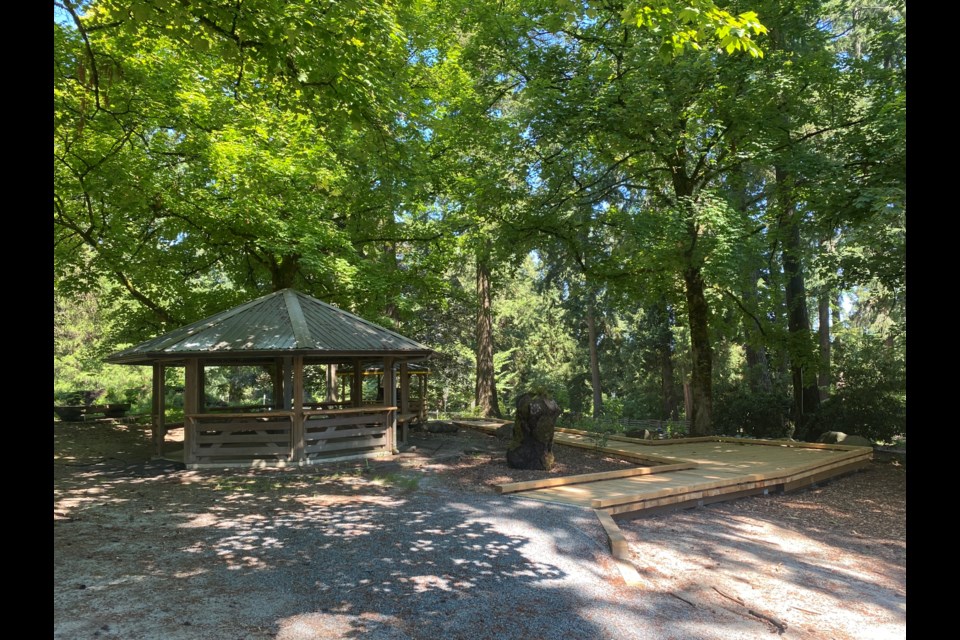An area of Queen’s Park that once housed animals in a petting farm each summer is transitioning to a place that supports year-round programming.
The City of New Westminster recently completed Phase 1 of the Queen’s Park Farm transition master plan.
“This area is now referred to as The Habitat area,” Erika Mashig, the city’s manager of arboriculture, horticulture, parks, and open space planning, recently told council. “There has been installation of restoration, ecological features, and new access boardwalk. There are also new types of programming being introduced into the farm.”
The Habitat will ultimately provide a naturalized space that supports biodiversity as well as year-round outdoor programming and activities.
“The transition of the Queen’s Park Farm from livestock to habitat represents a commitment to deepen the connections between people and the ecosystems that sustain life in the city,” Mayor Patrick Johnstone said in a news release. “The Habitat will support opportunities to play, learn, and gather outdoors with programs and activities designed to develop long-lasting environmental literacy and stewardship.”
Phase 1 of the Queen’s Park Farm transition master plan included removing the huts and feeder structures and retrofitting the two gazebo structures to support year-round programming. The outdoor gazebos have been renovated so they are usable for outdoor public classes and workshops.
A City of New Westminster news release said the city partnered with the Rotary Club of New Westminster to install a wooden boardwalk along the edge of the wetland bog, as a way of creating a more inclusive space for all ages and abilities. The Rotary Club provided volunteer labour as well as $40,000 to fund construction of the boardwalk.
The city collaborated with artist Dr. T’uy’t’tanat Cease Wyss (Skwxwu7mesh, Sto:lo, Hawaiian, Swiss), as well as Indigenous youth artists and creators, to implement restorative features that support native fauna and flora. Staff also collaborated with mycologist Willoughby Arevalo, who is an artist and author, to inoculate logs to grow shiitake mushrooms.
“We thank the Rotary Club of New Westminster for their significant contribution in assuring that The Habitat is accessible for all community members,” Johnstone said, “and all the artists and experts who have collaborated with the City of New Westminster to advance the goals and objectives of the Queen’s Park Farm transition master plan.”
According to the city, completion of Phase 1 means The Habitat now hosts a wide range of ecological features: huglekultur, which are mounds of woody material that will eventually transform into highly fertile garden beds; swales and berms, which enable the collection of rainwater and allows it to better infiltrate the soil; mushroom logs, for demonstrating fungi diversity; nurse logs, for supporting seedlings; and a wetland bog, to support plants, fish, birds, and other animals.
Planning and design work is underway for Phase 2 of the transition project, said the city’s news release.
Programming begins
The petting farm operated in Queen’s Park from the Victoria Day to Labour Day, providing a summer home to animals including goats, pigs, chickens, rabbits, and peacocks. It had operated in the space for decades, but the city used the closure resulting from the COVID pandemic as an opportunity to consider the future use of the space.
The master plan outlined a variety of potential programming opportunities for the space in Queen’s Park, including potlucks, long table dinners, movie screenings, workshops on a variety of ecological, food and growing, and arts and culture topics.
The fencing that once kept animals contained in the petting farm has been removed, giving park goers the ability to meander through The Habitat space at any time.
The City of New Westminster kicked off programming at the space with a Welcome to the Habitat session on July 12, where community members could explore the new space, talk to the staff involved in the project, and learn more about the design features. Other programming has included a Meet the Bee Club session with the New Westminster Beekeeping Association (which has a Bee Yard in Queen's Park) and an Outdoor Art Gallery presented by Arts New West.
Community members are invited to attend a free basket weaving session at The Habitat on Saturday, Aug. 10 from 10:30 a.m. to 12:30 p.m., where they will learn the art of weaving pine needle baskets. The session is of all skill levels (anyone over 10 years of age who can safely use a sewing needle can attend) and is free.
More about the Queen’s Park Farm transition master plan and The Habitat project can be found on the city’s website.
The master plan recommended the space be used to: promote principles of environmental stewardship and habitat restoration; encourage community members to recognize food in nature; grow edible plants that will inherently foster wildlife habitat; provide resilient interventions and stewardship opportunities to withstand frequent use and help reduce need for intensive maintenance; offer interactive educational opportunities that engage with Indigenous knowledge and traditions; and actively engage toddlers (ages 18 months to 4 years) and young children (ages five to 12 years+) with play, exercise, and exploration, including experiential features that do not require reading to have an element of learning.
Not everyone has supported the plan to replace the petting farm with The Habitat. In April 2023, council voted 5-2 in support of adoption of the Queen’s Park Farm master plan, with the mayor and councillors Ruby Campbell, Tasha Henderson and Nadine Nakagawa supporting the plan and councillors Daniel Fontaine and Paul Minhas voting in opposition.
According to the April 2023 staff report, the Phase 1 work had a budget of $160,000, which included planning, design, and implementation of Phase 1 of the master plan. An additional $350,000 is proposed in 2027 for implementation of Phase 2 of the master plan, but staff plan to seek grant funding to potentially implement subsequent phases of the master plan sooner than 2027.




